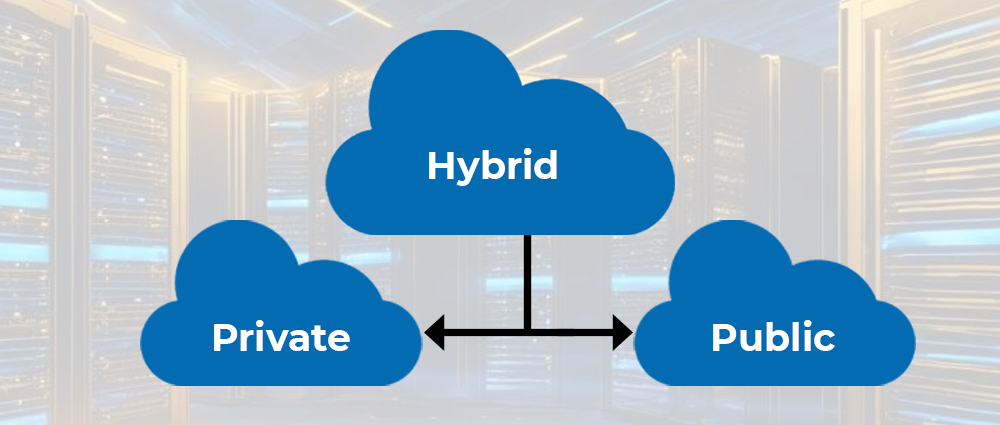Public vs Private vs Hybrid Cloud: Models and Suitable Use Cases

As the world continues to navigate the fast-evolving digital landscape, the need for reliable, scalable, and secure computing solutions has become more important than ever. This is where cloud computing comes in, offering a flexible and cost-effective way to store, manage, and access data and applications. Navigating the different cloud models can be baffling, however.
This blog explores the three main models: public cloud, private cloud, and hybrid cloud, dissecting their key differences and highlighting the most appropriate use cases for each.
Public Cloud vs Private Cloud vs Hybrid Cloud
Here are the major differences between the three key models.

Public cloud:
Imagine a massive, shared pool of computing resources (servers, storage, networking) owned and managed by a cloud service provider (CSP) like Amazon Web Services (AWS), Microsoft Azure, or Google Cloud Platform (GCP). These resources are accessible to anyone with an internet connection and a pay-as-you-go pricing model. This model is often likened to renting an apartment – you share the building and amenities with others, but have your own dedicated living space.
Private cloud:
This model is essentially the opposite of a public cloud. Here, the infrastructure is dedicated to a single organization and operates solely within their data center or through a managed service provider. This offers a high degree of control, security, and customization but comes with the added responsibility of managing and maintaining the infrastructure yourself. Think of it as owning your own house – you have complete control but are also responsible for all upkeep and maintenance.
Hybrid cloud:
This model combines both public and private cloud environments, creating a flexible and robust infrastructure. Organizations can leverage the scalability and cost-effectiveness of the public cloud for non-critical workloads while maintaining sensitive data and applications on the secure private cloud environment. This model is like having both a house and an apartment – you can enjoy the comfort of your own space while having the flexibility of the public option when needed.
Key Differences Between Public & Hybrid Clouds
Understanding the differences between public and hybrid clouds is crucial for making informed decisions. Here’s a breakdown of the key points:
| Feature | Public Cloud | Hybrid Cloud |
| Infrastructure | Shared with multiple users | Dedicated to a single organization |
| Management & Control | Managed by the CSP | Shared between organization and CSP |
| Security | Moderate control | High level of control |
| Scalability | Highly scalable | Scalable with public cloud integration |
| Cost | Pay-as-you-go model | Combination of fixed and variable costs |
| Suitable for? | Non-critical workloads, web applications, development & testing | Sensitive data, regulatory compliance, workloads with fluctuating demands |
Understanding Public vs Private vs Hybrid Cloud Use Cases
Choosing the right cloud model depends on your specific needs and priorities. Here are some examples of suitable use cases for each:

Public cloud:
Web applications and websites: Public cloud offers a cost-effective and scalable solution for hosting websites and web applications with fluctuating traffic.
Email and collaboration tools: Cloud-based email services and collaboration tools are readily available in the public cloud, offering ease of access and scalability.
Development and testing environments: Public cloud provides a cost-effective platform for setting up and tearing down temporary development and testing environments.
Private cloud:
Financial data and applications: Organizations dealing with sensitive financial data may choose a private cloud for its enhanced security and control.
Healthcare data and applications: Similar to financial data, healthcare information often requires the high level of security and compliance offered by a private cloud.
Industry-specific applications: Certain industries like telecommunications may have specific regulatory requirements that necessitate a private cloud environment.
Hybrid cloud:
Organizations with fluctuating demands: This model allows businesses to leverage the public cloud for peak periods, while keeping core applications and sensitive data secure within the private cloud.
Disaster recovery and backup: Sensitive data can be stored in the private cloud, while backups can be replicated to the public cloud for faster recovery in case of a disaster.
Compliance and regulatory requirements: Organizations with specific compliance requirements can leverage both public and private cloud environments to meet regulations while still enjoying the benefits of the public cloud.
Conclusion
Public cloud, private cloud, and hybrid cloud each offer unique advantages and disadvantages. By understanding these models and their suitable use cases, organizations can make informed decisions about their cloud strategy, ensuring it aligns with their specific needs in terms of security, scalability, cost, and compliance.

 Careers
Careers


